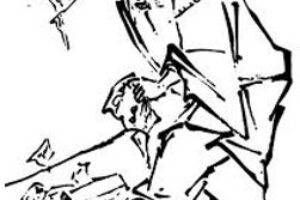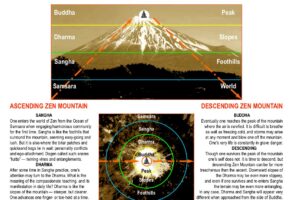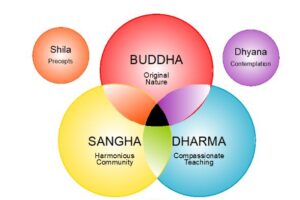
First let’s challenge the idea that we are, actually, doing the same thing again and again, when we meditate.
This question comes up often amongst practitioners of Zen. Even those who have been training in zazen for years will sometimes seem to “plateau,” interpreting their experience as flattening out, hitting a wall, etc. And for newcomers, this is often the most persistent, nagging concern, when they do not see immediate results. It is easy to say, “just sit,” in the face of this and all other discouragement that arises, but it is also too facile. We want to encourage raising this point again and again.
Our new Thursday evening program at ASZC, “ZENtalk,” is focused on this question. We interview various folks at different stages of training in Zen, from the rank newcomer to old-timers, as well as the occasional guest who may have no experience at all with Zen, but may be pursuing another, related path of interest. The “show” is featured online on our Facebook page and archive on our YouTube channel, as well as streamed live on Mixlr.
We feel it is increasingly important, at this time and in this cultural milieu, to allow the general audience interested in Zen to hear from people from all walks of life, and diversity in terms of age, gender, ethnicity, profession, etcetera, as to why they practice its strict form of meditation, zazen. Zen is mainstreaming in America, but it is still not understood, let alone practiced, by anywhere near a majority of our fellow citizens. Without first-person testimony as to the uniqueness of Zen’s stripped-down design for upright, “quiet illumination” meditation, it is likely to be lost in the smorgasbord of popular meditations currently on offer in the public realm.
Bill Murray, mentioned in last month’s Dharma Byte in relation to his performance in “Scrooged,” also starred in an iconic film that seems to be in constant rerun status on TV, “Groundhog Day.” He wakes up, day after day, to the same day — marked by the iconic, but irritating, “I Got You Babe” by Sonny Bono — on his radio alarm. But he is the only one who is aware of this anomaly in the ordinary passage of time. As a consequence, he becomes liberated from his obsessive approach to doing what he is supposed to be doing — namely reporting on Punxutawney Phil, the groundhog, an assignment he feels is beneath his dignity — and finds that he has the time to do the many, more meaningful things he always wanted to do, including play jazz piano, and mastering ice sculpture. He also finds the time to fall in love with, and to woo, and win, the love of his life.
The plot is said to mimic the life of a Bodhisattva, according to one online commentator (see https://tricycle.org/trikedaily/groundhog-day/). The article leads off with a quote from Master Dogen:
The life of one day is enough to rejoice. Even though you live for just one day, if you can be awakened, that one day is vastly superior to one endless life of sleep. . . . If this day in the lifetime of a hundred years is lost, will you ever touch it with your hands again?
Note the reference to an endless life of sleep. When Buddha came down off of the mountain, the story goes, his fellow ascetics, noting he had changed in aspect, asked him what he was. He is said to have said, “I am awake; I am fully awake.” He was thereafter called Buddha, which means the fully awakened one. We value life itself, going to great lengths to extend it, but in Zen it is considered worthless unless lived fully, in other words, unless we, too, wake up.
This brings up an oversimplification of the fundamental proposition of Zen: We were all asleep last night (with the exception of the night shift), and we all woke up this morning. And we know the difference, which is like night and day. Buddhism suggests that we are still asleep, to a degree, and that we can still wake up from this so-called waking state. And that we will just as surely know the difference.
If and when this change occurs, it changes everything, yet changes nothing. Nothing in the world is magically changed, yet the meaning of our life, with all its dreariness, changes for the better, and completely.
I have to admit that as time goes on, my own daily life often seems to be a rerun of the same-old-same-old patterns of demands and responses. For example, when I am striving to meet a deadline, and especially when nothing seems to be working. Mindlessly doing the same thing over and over, hoping for different results, is a well-known version of the famous line, “that way lies madness,” from “King Lear.”
But in Zen, we intentionally do the same thing over and over: we meditate. So are we hoping for different results, with consequent disappointment? Or are we not expecting different results. Can we meditate without expecting any results at all?
First let’s challenge the idea that we are, actually, doing the same thing again and again, when we meditate. One of the most artful accomplishments of “Groundhog Day” is that the same scenes are filmed again and again, with only Bill Murray’s part differing, as far as can be detected, at least, from the vicarious perspective of the viewing audience.
Having worked on a feature film as prop master — where my role was to make sure that all the material props in a given scene stay where they are supposed to be, take after take, instead of magically moving from one spot to another — I can appreciate how difficult, technically, that must have been. I feel sure that if you were to compare like scenes from “Groundhog Day” side-by-side, you would be able to point out the subtle differences. But in the theater, with the flow of time, short-term memory detail is lost. And the suspension of disbelief allows for the repetitive scene to be perceived as a perfect do-over.
But in fact, of course, it is physically impossible to replicate the same events, the same action, the same dialog, twice. So again, kudos to the skill of the actors, director and cameramen, not to mention the stagehands on the set, for the illusion.
If we apply the same concept to meditation, we can see that it is not really possible for any two periods of zazen to be exactly the same. Everything in the ambient environment is different, though we do our best to keep it the same in the zendo. This does not mean than zazen is a process of paying ever more attention to ever less significant, and trivial aspects of our sensory awareness. But training our mind to note the smallest change that may arise unexpectedly trains it to note the big picture as well. Which seems to be changing at yet an even slower rate. The forest seems to change at a higher frequency than the mountain on which it grows.
More importantly, everything in our life may seem unchanging, but is actually very different from one day to the next. These concerns usually form the content of our meditation, which, therefore, can never be exactly the same, either. Even in the same day of a retreat, each meditation session transpires in a different part of the day, and so cannot be anywhere near the same, actually.
Further, in an hour of sitting, our location on the planet, relative to the spin of rotation, places us roughly a thousand miles east of where we started out, if I have the physics correct. Of course, a star may have gone nova somewhere in that time as well, but as long as it is not old Sol, we are blithely unaware of such a cataclysmic change. All things are like this. Behind the apparent continuity of the surface of our lives, is continual discontinuity. The forces of nature, as well as of human activities, are conspiring to spring the next surprise.
Beyond our own, personal practice, the social relationships we have to the others in the Zen center, as well as in our other daily life communities at home, work and play, are also ever-changing. That we, ourselves, are changing moment-by-moment, means that everyone else that we know is in transition, also. Thus, our relationships are changing moment by moment — squared — so to speak; though they may seem to remain painfully, or joyfully, unchanging.
This is where the life of the Bodhisattva comes into play, in our own lives.
This is the point at which I stopped reading this essay to the Zen center audience. I asked them to consider where they saw the role of the Bodhisattva coming into their lives. Here I would like to ask you the same thing.
First to those unsatisfactory, and even disconcerting, relationships we have with others in our daily transactions, magnified and multiplied by today’s engagement with media, both social and traditional. There is an expression in Zen, “negative bodhisattva,” which you may have heard, which defines those who are teaching us the Dharma in ways that we may not welcome, or appreciate. In “Groundhog Day,” the obnoxious insurance salesman — who accosts Bill Murray each day, causing him to step into the freezing cold puddle, and whom his character finally punches in the face — would represent the archetype for such unintentional mentors. Well-meaning enough, perhaps, but totally blind to the inappropriateness, and destructive results, of their behavior.
Then there is the little item of our own actions, as being those of a mindless bodhisattva, bumbling along in our own little world, unaware of the trail of debris we are leaving in our wake. We are not consciously acting as a Bodhisattva when, for example, we decide we need to teach someone a lesson. We end up teaching them a lesson, all right, just not the lesson we intended them to learn. This recalls a strip from “Pogo Possum,” the delightful work of Walt Kelly, in which Albert the alligator is irate at someone for some reason. When another character says he should teach them a lesson, he shouts “I don’t want to teach them; I want to learn them.” When we try to learn someone something, they mainly learn something about us.
So perhaps coming to apprehend the Bodhisattva Vow, as a genuine thread in our life, is not so much a matter of awakening the kind of compassion that makes us commit to spending our lives on behalf of others, as it is waking up to the fact that this is what is already happening, whether we know it or not. We may just be doing a woefully inadequate job of it.
When we see that our behavior has effects upon others — either in the negative sense of a counterbalancing reaction to our errors; or in the positive sense that they remain unperturbed by our ignorant and heedless behavior — the logical thing, indeed the only thing, may be to begin to take that into consideration in the first place. Before we act, or react, without seeing ourselves reflected in the big picture, the mirror of Zen. Being a Bodhisattva, then, in the final interpretation, is just being a normal, woke person.
This is what is meant in Zen, I think, by such expressions as “nothing special” and “The Zen mind is the ordinary mind.” This is the mind of Hsinhsinming, the final Mind in which we can, and must, place our trust. Especially when our practice seems to have flat lined, and we are not getting anywhere with it, like so many other dimensions of our lives.
If we can practice without expectations — without even any expectation of not having expectations — then we may penetrate to this deeper level of appreciation, the underlying current that brought us to Zen in the first place; indeed, that brought us into this existence in the first place. It is the very arising of doubt that indicates that we are getting close to something. If we take the feeling of doubt — which is admittedly not a pleasant feeling — as the content of our meditation, then it may have a surprise in store. The very feeling of doubt is the emotional content of faith. In Zen, this is not a blind faith in something we want to believe, but a kind of open-ended faith that, like it or not, we do not have any choice in this matter. We may believe that we can turn to some other path, but we will find that here is only one. It doesn’t matter what we call it. Zen points directly to the original path, the one that is no-path. Zazen is returning to the source of the path.








